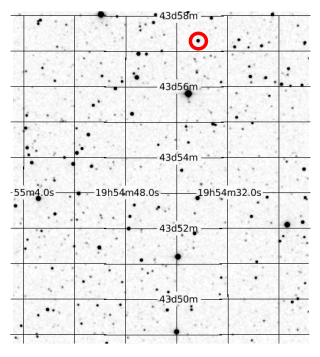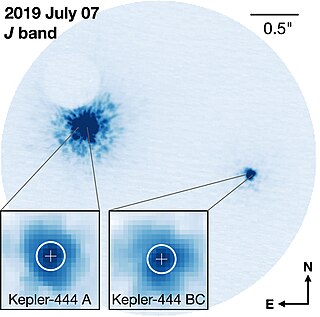Related Research Articles

Kepler-9 is a sunlike star in the constellation Lyra. Its planetary system, discovered by the Kepler Mission in 2010 was the first detected with the transit method found to contain multiple planets.
Kepler-39 is an F-type main sequence star located in the constellation Cygnus. It is located about 3,500 light-years away. One known substellar companion orbits it, Kepler-39b.
Kepler-80, also known as KOI-500, is a red dwarf star of the spectral type M0V. This stellar classification places Kepler-80 among the very common, cool, class M stars that are still within their main evolutionary stage, known as the main sequence. Kepler-80, like other red dwarf stars, is smaller than the Sun, and it has both radius, mass, temperatures, and luminosity lower than that of our own star. Kepler-80 is found approximately 1,223 light years from the Solar System, in the stellar constellation Cygnus, also known as the Swan.
Kepler-32 is an M-type main sequence star located about 1053 light years from Earth, in the constellation of Cygnus. Discovered in January 2012 by the Kepler spacecraft, it shows a 0.58 ± 0.05 solar mass (M☉), a 0.53 ± 0.04 solar radius (R☉), and temperature of 3900.0 K, making it half the mass and radius of the Sun, two-thirds its temperature and 5% its luminosity.
Kepler-65 is a subgiant star slightly more massive than the Sun and has at least four planets.
Kepler-66 is a star with slightly more mass than the Sun in the NGC 6811 open cluster in the Cygnus constellation. It has one confirmed planet, slightly smaller than Neptune, announced in 2013.
Kepler-67 is a star in the open cluster NGC 6811 in the constellation Cygnus. It has slightly less mass than the Sun and has one confirmed planet, slightly smaller than Neptune, announced in 2013.
Kepler-88 is a G-type star 1,230 light-years away in the constellation of Lyra, with three confirmed exoplanets. SIMBAD lists a subgiant spectral type of G8IV, while other sources give it a main sequence spectral type of G6V. The latter is more consistent with its properties.

Kepler-25 is a star in the northern constellation of Lyra. It is slightly larger and more massive than the Sun, with a luminosity 21⁄2 times that of the Sun. With an apparent visual magnitude of 10.6, this star is too faint to be seen with the naked eye.

Kepler-26 is a star in the northern constellation of Lyra. It is located at the celestial coordinates: Right Ascension 18h 59m 45.8408s Declination +46° 33′ 59.438″. With an apparent visual magnitude of 15.5, this star is too faint to be seen with the naked eye.
Kepler-102 is a star 353 light-years away in the constellation of Lyra. Kepler-102 is less luminous than the Sun. The star system does not contain any observable amount of dust. Kepler-102 is suspected to be orbited by a binary consisting of two red dwarf stars, at projected separations of 591 and 627 AU.
Kepler-30 is a star in the northern constellation of Lyra. It is located at the celestial coordinates: Right Ascension 19h 01m 08.0746s Declination +38° 56′ 50.218″. With an apparent visual magnitude of 15.5, this star is too faint to be seen with the naked eye. Kepler-30 is exhibiting a strong starspot activity.
Kepler-28 is a star in the northern constellation of Cygnus., It is orbited by two exoplanets. It is located at the celestial coordinates: Right Ascension 19h 28m 32.8905s, Declination +42° 25′ 45.959″. With an apparent visual magnitude of 15.036, this star is too faint to be seen with the naked eye.
Kepler-43, formerly known as KOI-135, is a star in the northern constellation of Cygnus. It is located at the celestial coordinates: Right Ascension 19h 00m 57.8034s, Declination +46° 40′ 05.665″. With an apparent visual magnitude of 13.996, this star is too faint to be seen with the naked eye. The Kepler-43 has a very strong starspot activity.
Kepler-45, formerly known as KOI-254, is a star in the northern constellation of Cygnus. It is located at the celestial coordinates: right ascension 19h 31m 29.495s, declination +41° 03′ 51.37″. With an apparent visual magnitude of 16.88, this star is too faint to be seen with the naked eye.

Kepler-186 is a main-sequence M1-type dwarf star, located 177.5 parsecs away in the constellation of Cygnus. The star is slightly cooler than the sun, with roughly half its metallicity. It is known to have five planets, including the first Earth-sized world discovered in the habitable zone: Kepler-186f. The star hosts four other planets discovered so far, though they all orbit interior to the habitable zone.

Kepler-444 is a triple star system, estimated to be 11.2 billion years old, approximately 119 light-years (36 pc) away from Earth in the constellation Lyra. On 27 January 2015, the Kepler spacecraft is reported to have confirmed the detection of five sub-Earth-sized rocky exoplanets orbiting the main star. The star is a K-type main sequence star. All of the planets are far too close to their star to harbour life forms.
Kepler-51 is a Sun-like star that is about 500 million years old. It is orbited by three super-puff planets—Kepler-51b, c, and d—which have the lowest known densities of any known exoplanet. The planets are similar in radius to gas giants like Jupiter, but have unusually small masses for their size, only a few times greater than Earth’s.
Kepler-411 is a binary star system. Its primary star Kepler-411A is a K-type main-sequence star, orbited by the red dwarf star Kepler-411B on a wide orbit, discovered in 2012.
Kepler-63 is a G-type main-sequence star about 638 light-years away. The star is much younger than the Sun, at 0.21 billion years. Kepler-63 is similar to the Sun in its concentration of heavy elements.
References
- 1 2 3 4 5 Vallenari, A.; et al. (Gaia collaboration) (2023). "Gaia Data Release 3. Summary of the content and survey properties". Astronomy and Astrophysics. 674: A1. arXiv: 2208.00211 . Bibcode:2023A&A...674A...1G. doi: 10.1051/0004-6361/202243940 . S2CID 244398875. Gaia DR3 record for this source at VizieR.
- 1 2 3 "Notes on Kepler-17 b". Extrasolar Planets Encyclopaedia . Retrieved 15 January 2017.
- ↑ McQuillan, A.; Mazeh, T.; Aigrain, S. (2013). "Stellar Rotation Periods of The Kepler objects of Interest: A Dearth of Close-In Planets Around Fast Rotators". The Astrophysical Journal Letters. 775 (1). L11. arXiv: 1308.1845 . Bibcode: 2013ApJ...775L..11M . doi: 10.1088/2041-8205/775/1/L11 .
- 1 2 "Kepler-17". SIMBAD . Centre de données astronomiques de Strasbourg . Retrieved 16 January 2017.
- ↑ Morris, Brett M.; Agol, Eric; Hebb, Leslie; Hawley, Suzanne L. (2018), "Robust Transiting Exoplanet Radii in the Presence of Starspots from Ingress and Egress Durations", The Astronomical Journal, 156 (3): 91, arXiv: 1807.04886 , Bibcode:2018AJ....156...91M, doi: 10.3847/1538-3881/aad3b7 , S2CID 119420137
- ↑ Valio, Adriana; et al. (2017). "Activity and Rotation of Kepler-17". The Astrophysical Journal. 835 (2). 294. arXiv: 1702.02213 . Bibcode: 2017ApJ...835..294V . doi: 10.3847/1538-4357/835/2/294 .
- ↑ Lanza, A. F.; Netto, Y.; Bonomo, A. S.; Parviainen, H.; Valio, A.; Aigrain, S. (2019), "Stellar activity and rotation of the planet host Kepler-17 from long-term space-borne photometry", Astronomy & Astrophysics, 626: A38, arXiv: 1904.04489 , Bibcode:2019A&A...626A..38L, doi:10.1051/0004-6361/201833894, S2CID 104292264
- 1 2 Désert, Jean-Michel; et al. (2011). "The Hot-Jupiter Kepler-17b: Discovery, Obliquity from Stroboscopic Starspots, and Atmospheric Characterization". The Astrophysical Journal Supplement Series. 197 (1). 14. arXiv: 1107.5750 . Bibcode: 2011ApJS..197...14D . doi: 10.1088/0067-0049/197/1/14 .
- ↑ Planet Kepler-17 b on exoplanet.eu